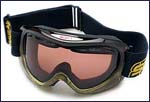That’s a drag about your knee, but very understandable. Depending on the time of day and weather conditions, just about all the light contrast on a ski slope can simply evaporate, leaving skiers all but blind when it comes to spotting changes in terrain. More than once, particularly in the late afternoon, I’ve been gliding along, happy as a clam and dumb as a rock, and suddenly found myself semi-airborne after hucking over an unseen ledge. What happens is that the snow and clouds combine with somewhat weak winter sun to perfectly diffuse the light, all but eliminating shadows.
 Scott Split Six
Scott Split Six
That’s why most ski goggles have a yellow tint. Yellow allows good light transmission—about 70 percent—while increasing contrast. But sometimes even that isn’t good enough. So lots of goggle makers also offer reddish or “persimmon” lenses. These jack up the contrast even more in low and flat light, helping you see previously unseen variations in the terrain.
The Scott Split Six goggle ($100 Canadian; www.scottusa.com) offers lenses of this type, as do the Oakley Wisdoms ($155 Canadian; www.oakley.ca). Trouble is, these reddish lenses also block a bit more light, allowing about 60-percent light transmission. That’s fine during the day, but for night skiing it’s not what you want. So for skiing under the lights, you’ll need to have spare goggles with yellow or even clear (really, your best option) lenses.
Check out the from the November ’04 issue of şÚÁĎłÔąĎÍř for the season’s best planks and boards, terrain parks, lodges, parties, and more.


